Common Types
For the sake of code reuse and reduction of complexity, most of the elements and
element attributes of schema are defined as separate types.
Simple Types
Simple types are used mostly within attributes.
For example, all reference types, defining ID/IDREF pairs value restriction, are
defined as simple types.
Here, only types that are used in multiple places of schema are indicated.
Types, specific to branches: species(atoms, molecules),processes (radiative,collisions)
are described in respective sections of this manual.
AngularMomentumProjectionType
Restriction of double type.
Allowed values: integer or half-integer. Examples: -11.5, 2,
+2.0, -0.5.
AngularMomentumType
Restriction of double type.
Allowed values: non-negative integer or half-integer. Examples: 11.5,
2, 2.0, 0.5.
DataDescriptionType
Descriptor for the type of a collisonal parameter, can take one of the
following values:
- crossSection
- collisionStrength
- rateCoefficient
- probability
- effectiveCollisionStrength
- sputteringYield
- sputteredEnergyCoefficient
- particleReflectionCoefficient
- energyReflectionCoefficient
- meanPenetrationDepth
DoubleListType
A list of values of type double
ElementSymbolType
Symbol for a chemical element.
Allowed values are atom symbols from the
[IUPAC] atomic elements list, from H for Hydrogen to Cn for Copernicium
EnvironmentIDType
Identifier for
Environments.
May contain any symbols except spaces, first symbol must be
E.
FunctionIDType
Identifier for
Functions.
May contain any symbols except spaces, first symbol must be
F.
MethodIDType
Identifier for methods of data production.
May contain any symbols except spaces, first symbol must be M.
MixingClassType
Indicates the nature of the mixing coefficients in the expansion of a
wave function in a specific basis. Allowed values:
NormalModeIDType
Identifier for vibrational normal modes for complex molecules..
May contain any symbols except spaces, first symbol must be V.
OrbitalAngularMomentumSymbolType
symbol for OrbitalAngularMomentumType, any lowercase letter is a valid value.
PrincipalQuantumNumberType
Allowed values: positive integer.
ReferenceFrameType
Descriptor for the frame of reference:
- CenterOfMass
- LaboratoryFrame
- TargetFrame
SourceIDType
Identifier for
Sources of data.
May contain any symbols except spaces, first symbol must be
B.
SpeciesIDType
Identifier for species. Used in Atoms and Molecules.
May contain any symbols except spaces, first symbol must be X.
If database keeps different species kinds in different tables, it may make sense to add some additional prefixes
to assure process identifier uniqueness, like XA for atoms, XM for molecules, etc.
StateIDType
Identifier for a specific state. Used in all species.
May contain any symbols except spaces, first symbol must be S.
ProcessIDType
Identifier for a specific process. Used in all processes for the mandatory id attribute.
May contain any symbols except spaces, first symbol must be P.
If database keeps different process kinds in different tables, it may make sense to add some additional prefixes
to assure process identifier uniqueness.
StringListType
Space-separated list of arbitrary strings.
UnitsType
Defines a list of allowed units within XSAMS document.
This list is updated and extended as necessary on data producers request.
[UnitsML] approach may be adopted in later versions of schema.
The positive powers are indicated by digits, the negative powers follow
the backslash symbol /.
For unitless (dimensionless) parameters, use unitless.
So far, this list contains the following values. If any additional values are required,
contact responsibles for schema.
- undef
- eV/amu
- keV/amu
- MeV/amu
- eV
- keV
- MeV
- au
- 1/cm
- J
- Ry
- unitless
- kJ/mol
- kcal/mol
- K
- Hz
- kHz
- MHz
- m
- cm
- A
- nm
- deg
- rad
- srad
- s
- m3/s
- cm3/s
- cm6/s
- m2
- cm2
- b
- Mb
- 1/s
- C.m
- J/T
- C.m2
- m/s
- cm/s
- C
- electron
- g
- amu
- kg
- 1/m2/s
- 1/cm2/s
- J/m2/s
- J/cm2/s
- 1/m2
- 1/cm2
- 1/m3
- 1/cm3
- J/m2
- J/cm2
- W/m2
- W/cm2
- W
- atm
- km/mol
- 1/cm2/atm
- 1/cm/atm
- cm5
- Torr
Complex Types
PrimaryType
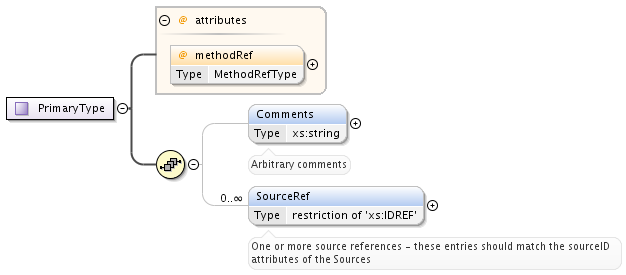
This is the fundamental elementary type used to built other types as
extensions. It may contain:
- optional methodRef attribute of type MethodRefType,
- list of SourceRef elements, containing source identifiers,
- optional Comments element for arbitrary comments.
ChemicalElementType
The mandatory element NuclearCharge must be a positive integer. The
optional element ElementSymbol must begin with an upper-case letter
which may be followed by a lower-case letter. Examples: P, T, Au.

DataType
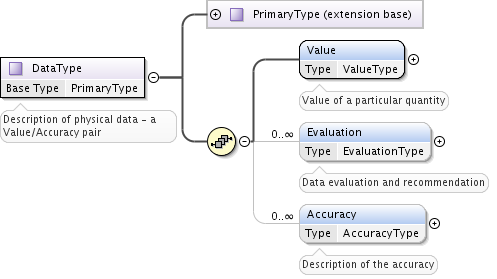
Extension of the PrimaryType which
is used for description of numerical data, including units and accuracy.
Contains
DataFuncType
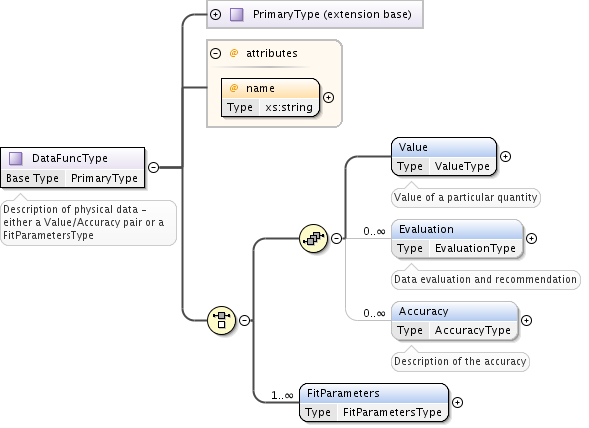
Defined in the similar way as DataType, DataFuncType has additionally
- mandatory name attribute,
- choice between a DataType elements and a list of FitParameters
elements, defined by FitParametersType, each containing sufficient set of parameters needed to calculate
the value using some Function.
It is used in Broadening and Shifting sections of [XSAMS] to define lineshape parameters.
AccuracyType
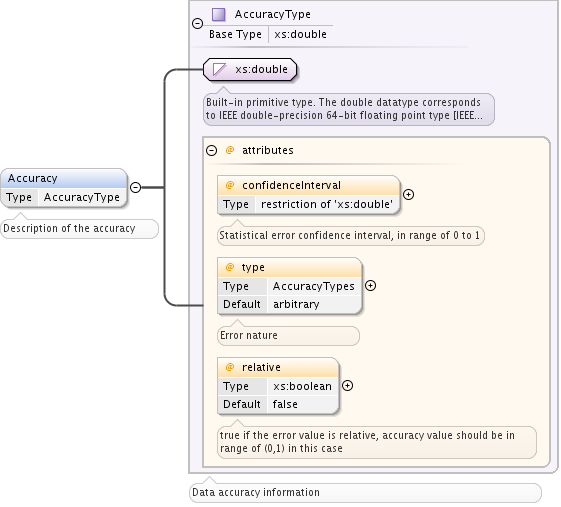
AccuracyType is an extension of xs:double type, adding optional attributes:
- type attribute that may take values
- arbitrary
- estimated
- systematic
- statistical
- confidenceInterval of type xs:double, with valid ranges from 0 to 1,
indicating confidence interval for the statistical error.
Ususal values would be like 0.95 or 0.99.
- relative of type xs:boolean, indicating whether this accuracy value
is absolute(false) or relative(true).
By default, accuracy should be treated as absolute.
EvaluationType
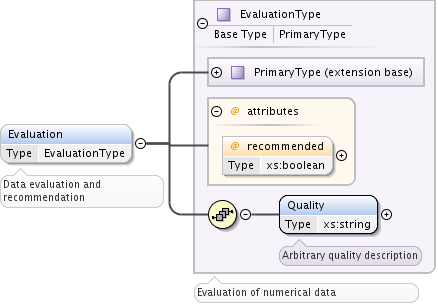
EvaluationType is an extension of the PrimaryType, intended to describe the data quality assessment and recommendation.
Following attributes and elements are defined:
- optional boolean recommended attribute, true if the corresponding value is evaluated and recommended
- optional string Quality element, intended to contain a string specific to evaluation commitee, describing the
data quality.
FitParametersType
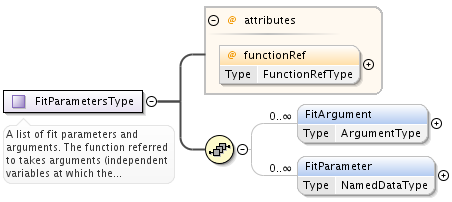
FitParametersType defines a full set of data required to calculate some quantity
using the predefined function. For a function definition, see Functions branch of XSAMS.
Following attributes and elements are defined:
- functionRef attribute, of type FunctionRefType,
defining the reference to a function used,
- list of FitArgument elements, of type ArgumentType, defining
validity limits of arguments in particular fit,
- list of FitParameter elements, of type NamedDataType,
giving the function parameters values, possibly with source references.
The NamedDataType is an extension of DataType with a mandatory name string attribute.
LifeTimeType
Extension of the DataType that defines the additional attribute decay
with possible values:
- total,
- totalRadiative,
- totalNonRadiative.
The type is used both in atomic and molecular states to define state lifetime.
SpeciesStateRefType
This type allows to define the SpeciesRef (SpeciesRefType) or
StateRef (StateRefType) child elements (or both).
At least one should be specified, but it is always kind to explicitly provide SpeciesRef.

ValueType
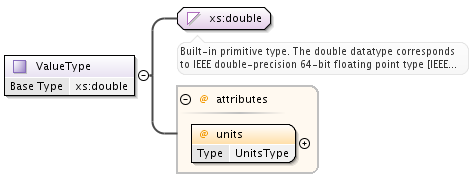
The data must be of type xs:double with the mandatory units attribute of type UnitsType
Data structures
In this section generic data structures that are used in multiple places in schema are described.
DataSeriesType
DataSeriesType allows description of data as a list of values or a linear sequence, including errors.
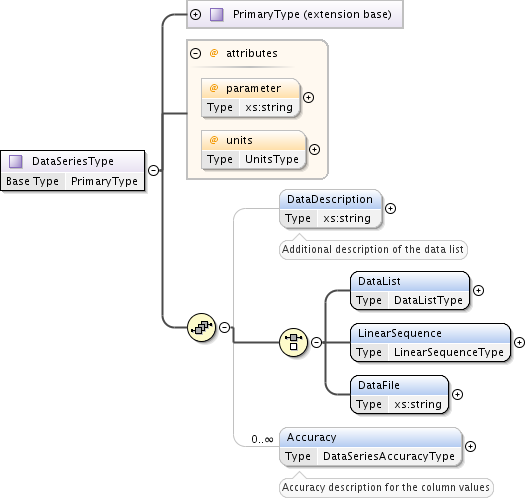
Extends PrimaryType to allow source references, adds following attributes and elements:
optional string attribute parameter that may contain the function
parameter name;
optional attribute units of UnitsType to define the data
units;
optional string Description element that may contain a verbose
description of data stored in the column;
mandatory choice of
DataList element of DataListType to represent a
space-separated list of double values.
LinearSequence element of LinearSequenceType. Should
be used if data is a linear sequence. Example would be to
represent frequency/wavelength points for spectrum data.
DataFile string element that should contain a file name,
containing space-separated or newline-separated set of data.
For now, this element should contain a fully qualified URL of
the data file. In a future xsams-bundle format this element will
contain names of bundled text files.
optional Accuracy elements, defined by the DataSeriesAccuracyType, similar to one in DataType
DataSeriesAccuracyType
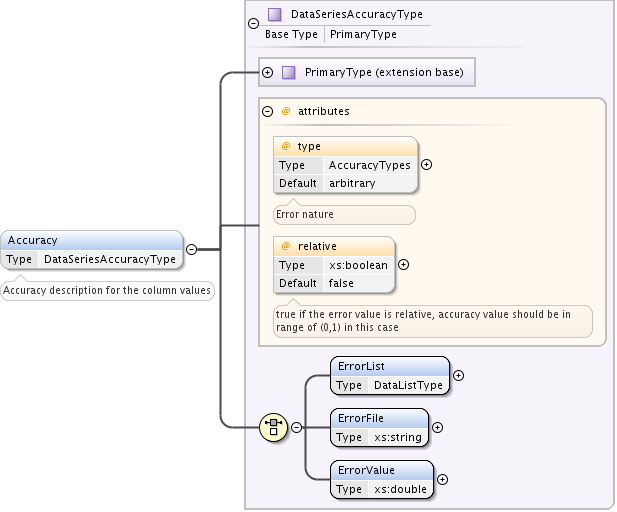
To represent data points errors, optional Accuracy element is introduced.
It extends PrimaryType by adding following attributes, similar to introduced in AccuracyType :
- string type attribute which may be arbitrary, estimated, statistical, systematic
- boolean relative attribute
one of the following optional elements may be used to describe error values:
- ErrorList element of DataListType,
- ErrorValue in case all points have the same error value
- ErrorFile which has the same meaning as DataFile element
All missing or unknown error values in the ErrorList and ErrorFile should be reported as -1.
DataListType
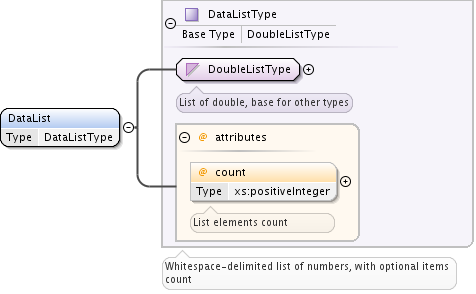
Defines a space-separated list of double precision floating-point numbers, with
the optional count attribute to indicate the number of elements in a list
LinearSequenceType
Allows to describe a linear sequence of data, in form of:
a_0, a_0+a_1, a_0+2a_1, ..., a_0 + (n-1)\cdot a_1
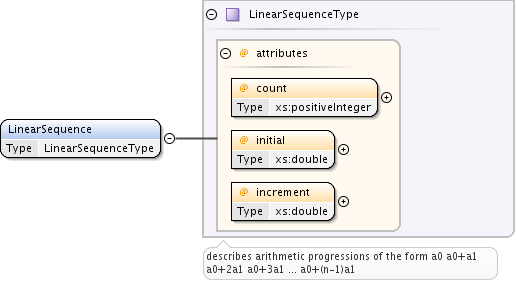
Defines three mandatory attributes: initial, increment and count.
SimpleDataTableType
SimpleDataTableType is the universal table type used as a base type for absorption cross-sections
and for all kinds of tabular data within collisions.
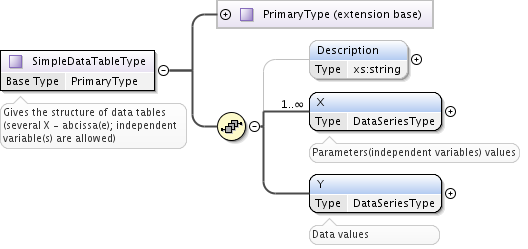
SimpleDataTableType has following attributes and elements defined:
- optional string Description to hold the table name;
- mandatory X element of DataSeriesType that can be repeated multiple times to
allow description of multi-dimensional data, as for example y=f(x_1, x_2, x_3).
- mandatory Y element of DataSeriesType intended to contain data points.
It is possible to mix DataList, DataFile and LinearSequence elements within a single table.
In any case each numerical list from any X or Y element must have the same number of values.
This is necessary to transfer the numerical data in a consistant way.
This way, the n’th value of the DataList element of the Y element has as argument values
the n’th value of the DataList element from each X elements. It is important to note
that no missing values are possible within the DataList element, as each Y value
has always a defined set of X values.
The only exception to this rule is a LinearSequence element that may contain less elements.
In this case when the last element is reached, value should be reset to initial
and begin to increment again.
The following table:
Differential cross-sections in 10^{-16} cm^2
| x1(eV)|x2(deg) |
0 |
20 |
40 |
|---|
|
.1 |
.2 |
.3 |
|
.4 |
.5 |
.6 |
|
.7 |
|
.9 |
produces as output:
<X units='deg'>
<Datalist>0 20 40 0 20 40 0 40</Datalist>
</X>
<X units='eV'>
<Datalist>1. 1. 1. 2. 2. 2. 3. 3.</Datalist>
</X>
<Y units='cm2'>
<Datalist>.1e-16 .2e-16 .3e-16 .4e-16 .5e-16 .6e-16 .7e-16 .9e-16</Datalist>
</Y>
VectorsType
Defines a collection of vectors in 3D space, specifying source reference,
dimensions units and vector reference frame.

Both VectorsType and Vector are extending PrimaryType.
VectorsType defines units attribute of type UnitsType and a collection of
Vector elements.
Vector has following attributes:
- string ref that is context-specific and defines the reference element to which
the vector applies,
- three xs:double coordinate attributes: x3, y3, z3,
with units defined in the Vectors container.
MatrixType
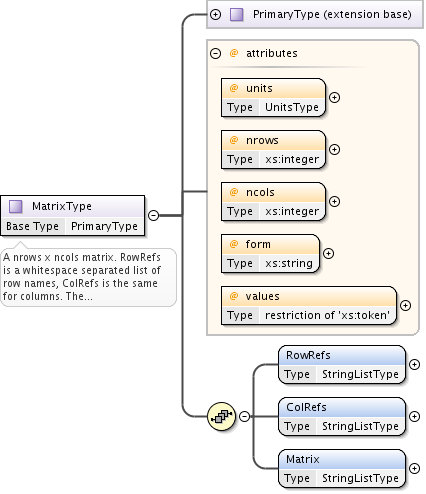
A nrows x ncols matrix.
Being an extension of the PrimaryType, MatrixType defines following elements and attributes:
- mandatory RowRefs element that contains whitespace separated list of row names,
- mandatory ColRefs element that contains the same list for columns.
- mandatory Matrix element that contains a whitespace separated
list of values, either real or complex
- mandatory integer attribute nrows defining the number of rows,
- mandatory integer attribute ncols defining the number of columns,
- mandatory attribute form that identifies the type of matrix. It can be
- arbitrary
- symmetric
- asymmetric
- diagonal
- antidiagonal
- mandatory attribute values that describes the type of Matrix element contents and may be
one of
- binary
- integer
- real
- imaginary
- complex
For an arbitrary matrix, Matrix element has nrows*ncols entries. First you output elements of the first row,
starting from the leftmost column.
| |
c1 |
c2 |
c3 |
| r1 |
0 |
1 |
2 |
| r2 |
3 |
4 |
5 |
| r3 |
6 |
7 |
8 |
<MatrixData units="arbitrary" nrows="3" ncols="3" form="arbitrary" values="integer">
<RowRefs>r1 r2 r3</RowRefs>
<ColRefs>c1 c2 c3</ColRefs>
<Matrix>
0 1 2 3 4 5 6 7 8
</Matrix>
</MatrixData>
For diagonal and antidiagonal matrix there are nrows=ncols entries, counting from left to right
| |
c1 |
c2 |
c3 |
| r1 |
1 |
0 |
0 |
| r2 |
0 |
2 |
0 |
| r3 |
0 |
0 |
3 |
<MatrixData units="arbitrary" nrows="3" ncols="3" form="diagonal" values="integer">
<RowRefs>r1 r2 r3</RowRefs>
<ColRefs>c1 c2 c3</ColRefs>
<Matrix>
1 2 3
</Matrix>
</MatrixData>
| |
c1 |
c2 |
c3 |
| r1 |
0 |
0 |
3 |
| r2 |
0 |
2 |
0 |
| r3 |
1 |
0 |
0 |
<MatrixData units="arbitrary" nrows="3" ncols="3" form="antidiagonal" values="integer">
<RowRefs>r1 r2 r3</RowRefs>
<ColRefs>c1 c2 c3</ColRefs>
<Matrix>
1 2 3
</Matrix>
</MatrixData>
For a symmetric matrix there are nrows(nrows+1)/2 entries.
| |
c1 |
c2 |
c3 |
| r1 |
1 |
2 |
3 |
| r2 |
2 |
4 |
5 |
| r3 |
3 |
5 |
6 |
<MatrixData units="arbitrary" nrows="3" ncols="3" form="symmetric" values="integer">
<RowRefs>r1 r2 r3</RowRefs>
<ColRefs>c1 c2 c3</ColRefs>
<Matrix>
1 2 3 4 5 6
</Matrix>
</MatrixData>
















